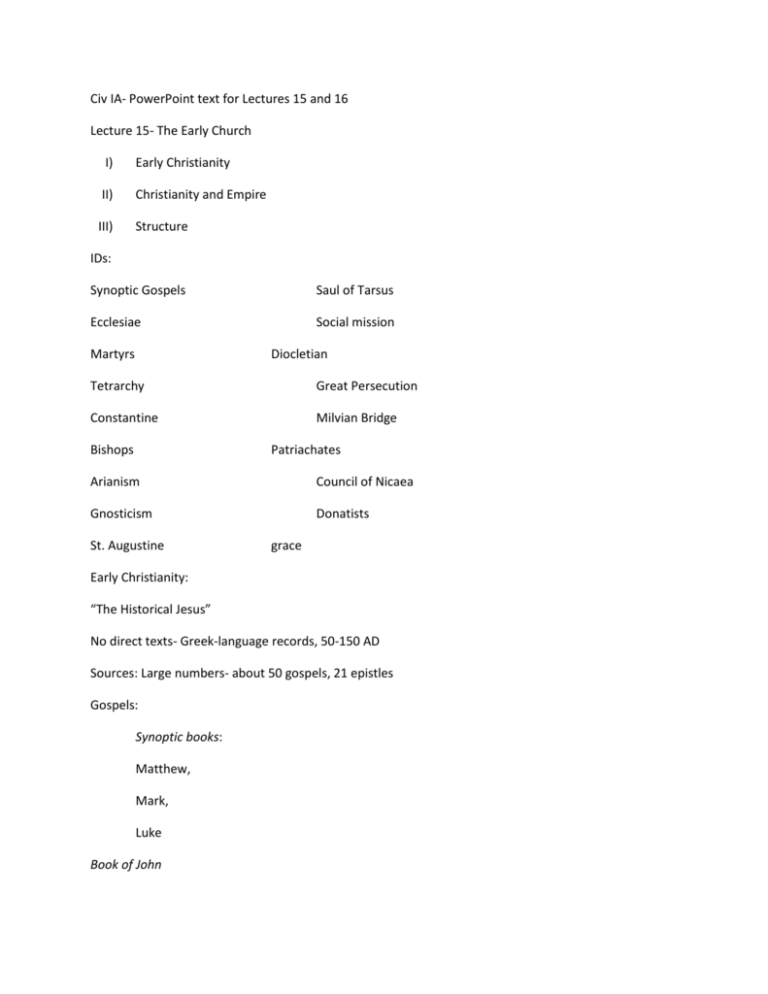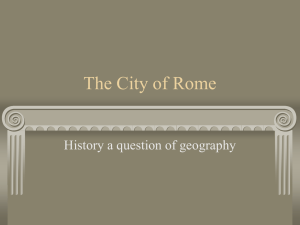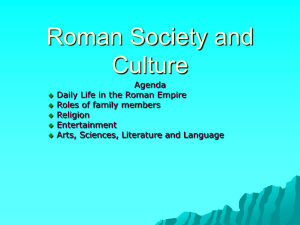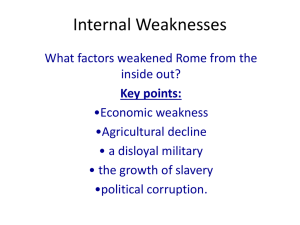Civ IA- PowerPoint text for Lectures 15 and 16 Lecture 15
advertisement

Civ IA- PowerPoint text for Lectures 15 and 16 Lecture 15- The Early Church I) Early Christianity II) Christianity and Empire III) Structure IDs: Synoptic Gospels Saul of Tarsus Ecclesiae Social mission Martyrs Diocletian Tetrarchy Great Persecution Constantine Milvian Bridge Bishops Patriachates Arianism Council of Nicaea Gnosticism Donatists St. Augustine grace Early Christianity: “The Historical Jesus” No direct texts- Greek-language records, 50-150 AD Sources: Large numbers- about 50 gospels, 21 epistles Gospels: Synoptic books: Matthew, Mark, Luke Book of John Acts and Epistles Revelations Post-Crucifixion Christianity (after 30 AD) Resurrection Peter Jewish context New elements Baptism Eucharist Saul (Paul) of Tarsus (c.10-c.63 AD) Observant Jew Also a Roman citizen Universal mission Debate within early Church (Acts of the Apostles, Chapter 15) Spread of Christianity before 200 AD Ecclesiae Trading cities <10,000 by 100 AD 200,000 by 200 AD But only .3% of total imperial population (60 million) Social Mission of Christianity II) Christianity and Empire Roman Persecutions of Christians Reaction to early problems - ex. Nero Monotheism as unpatriotic “Atheism,” etc. Sporadic Intensifies during the 3rd-Century Crisis Saint Perpetua’s martyrdom (203 AD) Now dawned the day of their victory, and they went forth from the prison into the amphitheatre as it were into heaven, cheerful and bright of countenance; if they trembled at all, it was for joy, not for fear. Perpetua followed behind, glorious of presence, as a true spouse of Christ and darling of God; at whose piercing look all cast down their eyes. . . . For she said: For this cause came we willingly unto this, that our liberty might not be obscured. For this cause have we devoted our lives, that we might do no such thing as this; this we agreed with you. . . . Perpetua began to sing, as already treading on the Egyptian's head. Revocatus and Saturninus and Saturus threatened the people as they gazed. Then when they came into [Governor] Hilarian's sight, they began to say to Hilarian, stretching forth their hands and nodding their heads: You judge us, they said, and God you. . . . Then truly they gave thanks because they had received somewhat of the sufferings of the Lord. Christianity and Suffering Two Major policies of Diocletian (r. 284-305) Overextended empire 1) Tetrarchy: East and West sections Augustus- senior Caesar- junior Dominus 2) “Great Persecution” Constantine (r. 306-337) Successor to Diocletian Internal fighting Battle of Milvian Bridge Vision Constantine’s conversion (?) Expansion of Christianity after 300 AD Rapid growth 100 AD- 10K 200 AD- 200K 300 AD- 4m 400 AD- 30m Structurebishops: dioceses doctrine - orthodoxy East: Arianism Church and Empire Imperial orders vs. paganism, 340-360 AD - Ban on pagan sacrifice - Closing of temples - Removing Altar of Victory Continuing conflicts: Emperor Theodosius and St. Ambrose (390 AD) III) The Early Church Church Structure and Doctrine Conspiracy? Gnostic Gospels Church Councils Expansion of Christianity after 300 AD Rapid growth -4m in 300 -30m by 400 Chiliasts Structurebishops dioceses Major Patriarchates Jerusalem Antioch Alexandria Constantinople Rome (Petrine Succession) Expansion of Christianity after 300 AD Growth and faith Consistency? Doctrine- orthodoxy East and West Doctrine and debates- the East Eastern questions- Christology Arianism Arius (c.250-336 A.D.) Neoplatonism Emanations Spirit and Matter Matter as residue (Inferior) The Debate over Arianism Arianism vs. Trinitarianism Nicene Creed, 325 • Lecture 16: Monks, Barbarians and Byzantines I) Early Church (con’d) II) Barbarians ! III) Eastern Empire IDs: Council of Nicaea Gnostics Augustine Donatists/Pelagians Grace The City of God St. Antony St. Jerome St. Benedict The “Dark Ages” Huns Visigoths Romanization Feudalism Byzantine Empire cities and trade Justinian • Arianism vs. Trinitarianism • Nicene Creed, 325 • Arianism vs. Trinitarianism • Other debates on doctrine Eastern: Gnostics Western: Salvation (Community vs individual) Donatists - vs. “collaborators” Pelagians- purity • St. Augustine (354-430) Born in North Africa Early life Gifted convert Monk Debate vs. Donatists and Pelagians • Augustine’s Confessions • St. Augustine and Rome Attacks on Rome- c. 410) City of God Two cities: City of Man (Material World) City of God (Spiritual World) • Christian Monasticism: East and West Monk: Greek for “single, solitary” Reaction against materialism- asceticism 4th century (after Constantine) • Spread of Monasticism • Eastern Monasticism • Western Monasticism Less involved with visiting pilgrims More self-sufficient communities Influenced by St. Benedict of Nursia (c. 480-547 AD) - followed “The Latin Rule”: “brevity, flexibility, and moderation” • Spread of Monasticism • II) Barbarians! • General Historiographical Debate: The Western Empire (5th-6th Century AD) The “Fall” of Rome? Edward Gibbon (18th Century) Barbarians and the end of western civilization Beginning of “the Dark Ages” Transition Conversion of barbarians Not all was lost • Western Empire: Pre-Invasion Problems Diocletian’s split- 284 AD Eastern domination Frontiers Networks • II) Conquest • West Germanic Revolution Continued organization: Germans Goths • The Huns Arrive in Europe c. 370 AD Feared horsemen Broke the Gothic confederation Defeat the Ostrogoths (eastern Goths) Drove out Visigoths (western Goths) • The Visigoths (“Western Goths”) Refugees in Eastern Empire Mistreatment Adrianople- 378 Theodosius and concessions Westward movement Rome in 410 • The Sack of Rome • The Visigoths (“Western Goths”) Continued westward movement Move to Spain Settle down • The Huns and Rome Huns –440s AD Diverted at Troyes Rome in 451 Break through Roman defenses • Attila and Leo I • The Vandals Began in 406 AD Cut through Gaul and Spain North Africa by 430 Sack Rome in 455 AD • Barbarian retirement? Ataulf, Leader of the Visigoths: “At the start I wanted to erase the Romans’ name and turn their land into a Goth empire, as Augustus had done. But I learned that the Goths free-wheeling wildness will never accept the rule of law, and that the state with no law is no state. Thus I have more wisely chosen another path to glory: reviving the Roman name with Gothic vigor. I pray that future generations will remember me as the founder of a Roman restoration.” • “Romanization” of the Barbarians Non-Arian Christianity (C. of Nicaea) Roman Law Romance Languages Government Remaining Romans: lords and knights • Clovis the Merovingian (r. 485-511) German leader of the Franks Convert and Patron of Christianity Later re-named “Louis” • The Origins of Feudalism: 5th to 7th Centuries Breakdown of imperial networks Cities destroyed by the Vandals Regional governors retreat to manors Local warriors (“knights”) hired for Protection Little help from. Rome or Constantinople • III) The Byzantines • Byzantine Empire Eastern dominance - after 400 AD Cities and trade • Byzantine Cities • Byzantine Empire Cities and trade - tax money - mercenaries - bribes “Heirs” of Rome Justinian and Theodora (ruled 527-565 AD) • Emperor Justinian (ruled 527-565) and Empress Theodora Theodora’s origins and influence - determination - pragmatism - Monophysites Reunification of the Roman Empire • Justinian’s 3-Part Goal for Byzantine Empire “United by God Empire, and Laws”









